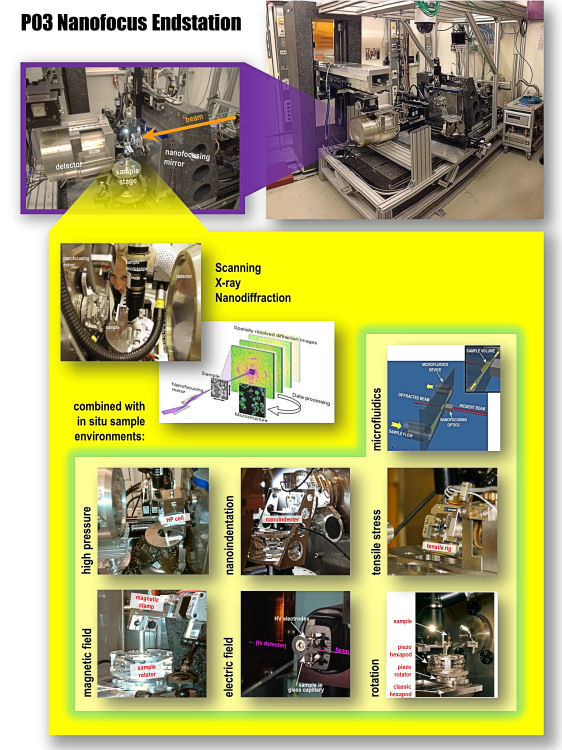Click on the magnifying glasses to open a high resolution image.
EH2 is the Nanofocus Endstation of P03 beamline and it is one of the very few places in the world that provide the experimental conditions for X-ray nanodiffraction in small and wide angle scattering experiments (SAXS/WAXS).
Scanning X-ray nanodiffraction an excellent tool for materials science. It readily serves structural information with sub-µm spatial resolution from crystalline and semi-crystalline materials (metals, biomaterials, synthetic compounds). That way grain orientation, residual stress profiles, crystal structure or texture can be obtained in a non-destructive analysis.
Because of the long focal distance focusing at the Nanofocus Endstation (up to 8 cm clear working distance), the wide energy range of the beamline (up to 23 keV) and a hexapod based positioning system, high resolution nanodiffraction experiments can be performed on strongly absorbing metallic samples and in extended sample environments. The spatial resolution with which data can be recorded is only limited by the beam size: we typically achieve a beam size of 350 nm x 250 nm with an integrated flux of 109 photons per second throughout the full energy range. If a slightly larger beam size is also acceptable, a high flux option (1010 photons per second) is available in a 1.5 µm beam. The detector types available at EH2 are a large size, high resolution CCD as well as pixel detectors with single photon characteristics. Please select the Unified Data Sheet for technical details on the detectors.
The strong focus on materials science at P03 is best demonstrated by the wide range of experiments already performed with in situ sample environments: stretching cells for tensile tests, a cryostream for temperature control, magnetic and electric field application, a nanoindentation apparatus and a high pressure cell for measurements at high hydrostatic pressure – all of these methods were successfully combined with the high spatial resolution provided by nanofocused beam. See figure below for general overview and details regarding distances and sample mounting.
The Nanofocus Endstation is maintained and operated by Helmholtz-Zentrum Geesthacht and it is the result of a fruitful cooperation between HZG, Kiel University and DESY. Beam time proposals are submitted via regular DESY systems (door.desy.de) and it is recommended to contact HZG staff ( Christina Krywka or Anton Davydok prior to submission in order toensure that all relevant issues are communicated before a proposal is written.







